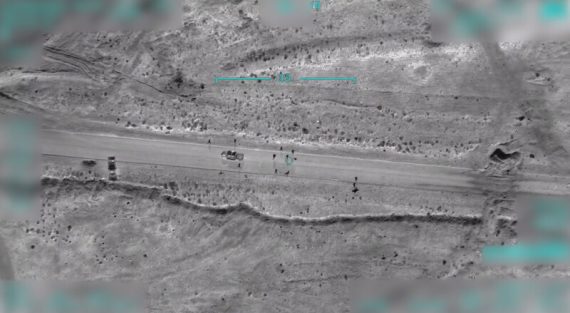D
uran Kalkan, a member of the PKK/KCK Executive Committee, described the operations carried out by Turkey’s National Intelligence Organization (MIT) against the organization’s top leadership as a declaration of “mobilization’’ aimed at purging the PKK leadership. Kalkan even targeted the terrorist wanted list prepared by the Ministry of Interior, lamenting that the PKK’s top leadership had been placed on a “death list.’’
Kalkan characterizes these operations as political pandering, and speaks openly against both the MIT and the Ministry of Interior at an institutional level. However, the targeting of the executive and operative elements of terrorist organizations by the security bureaucracy and its forces is not a new strategy. On the contrary, it is a part of the state’s counterterrorism policy that has been resolutely implemented for many years, and is expected to have strategic, operational, and political outcomes.
Tactical and strategic counterterrorism operations gain momentum
In the MIT’s 2022 annual activity report, Hakan Fidan, its director, underlines the activities carried out by Turkey’s security institutions to realize this successful counterterrorism policy. The MIT possesses proactive intelligence disciplines such as human intelligence, signals intelligence, electronic intelligence, and imagery and satellite intelligence, including unmanned aerial vehicle (UAV) capacity.
The MIT demonstrates its technological capacity and capabilities in cross-border operations that neutralize a terrorist organization’s leadership, destroy critical infrastructure facilities belonging to a terrorist organization, and capture many of its members, including the perpetrators of terrorist attacks in Turkey. In 2022 alone, 133 leaders and operative terrorist elements whose identities were shared in open sources were neutralized through internal security and cross-border operations.
Regardless of the terrorist organization and its area of operation, the counterterrorism operations discussed by Fidan continue to be carried out in 2023. The operation in Hasaka neutralized Zeki Gürbüz, the so-called Syria officer of the terrorist organization Marxist-Leninist Communist Party (MLKP), and Özgür Namoğlu, code-named “Fırat Neval,’’ the organization’s so-called Syrian sabotage officer; the operation in Qamishli neutralized Halil Menci who planned the 2022 Taksim attack; the operation that captured Ramazan Güneş, code-named “Soreş/Soreşger,’’ a member of the organization’s “special forces” who carried out 12 terrorist acts in Turkey, and brought him to Suleymaniye, Iraq; the operation in Sinjar neutralized the terrorist Saad Ali Bedel, code-named “Ceko Pir,’’ the so-called military commander of the PKK-affiliated Sinjar Defense Units (YBŞ); and the operation in Aleppo neutralized Mehmet Yıldırım, code-named “Hamza Kobani,’’ the so-called finance officer of Aleppo and Tel Rifat.
Such tactical and strategic counterterrorism operations which aim to eliminate the leadership cadres of the terrorist PKK organization have been effective since 2015 and have gained momentum in Turkey since 2018, in Iraq since 2019, and in Syria since 2022. These operations target the leader or the operative elements directly, and also involve coordinated operations in which the physical infrastructure and resources of the terrorist organization such as shelters, positions, arsenals, logistical support lines, rear basing points, and financial resources are targeted alongside the command control echelon.
Operations strike a psychological blow to the PKK
It would be useful to underline a few points in the process of carrying out these operations. Above all, the listing method is important in terms of facilitating the identification of organization leaders who are directly targeted and in terms of providing a legitimate basis for counterterrorism operations. The Ministry of Interior offers a reward of up to TL10 million for the location of terrorists on the red category list, TL 3 million for the blue list, TL 2 million for the green list, TL 1 million for the orange list, and TL 500,000 for the grey category list. The terrorism wanted list facilitates the identification, neutralization, capture, and prosecution of known terrorist elements; prevents the continuation of terrorist activities; and ranks members according to their roles within a terrorist organization and the magnitude of the impact of their terrorist activities, regardless of the ranking of the terrorist organization.
A similar practice is carried out by the U.S. State Department through the Rewards for Justice (RFJ) program. In fact, on November 6, 2018, U.S. Deputy Secretary of State Matthew Palmer announced that the U.S. State Department’s Rewards for Justice program would offer a reward for information leading to the identification or locational of three senior PKK leaders. The maximum reward was set at USD 5 million for Murat Karayılan, USD 4 million for Cemil Bayık, and USD 3 million for Duran Kalkan.
The execution of operations against a terrorist organization’s command cadre and qualified human resources is planned with extreme precision. In the case of a drone operation, for example, the first stage of the operation’s “target cycle’’ begins with the detection of the suspected target based on information from intelligence officers in the region or reconnaissance and surveillance activities carried out by UAVs.
Recommended
Following the detection of the target, the data received from the UAVs is used to identify the target by examining in detail the number of people, weapons, clothes, and whether the targets are civilians or not. After the identification process is completed, the targets in question are tracked by UAVs. At this point, tracking takes a few hours or a few days, depending on who the target is, and where and what kind of activity they is carrying out.
In the analysis phase, plans are made for the neutralization operation. In this context, special attention is paid that the target moves away from civilian areas and that there are no civilians in the operation area. In addition, information from intelligence officers in the field and data from the UAV center are compared. Ultimately, bearing all the data into consideration, when there is a definite conviction that the target is a terrorist element and there are no civilians around, a few operators destroy the target in accordance with the orders they receive from the relevant commander. After the target is neutralized, an evaluation phase is initiated and a report is prepared, thus ending the operation process.
As is evident from the statements of PKK member Kalkan, the psychological damage of these successful operations on the morale and motivation of the terrorist organization and terrorist elements is undeniable. According to the statements of captured or surrendered members of the organization, such operations cause confusion, anxiety, loss of authority, and give rise to situations in which subordinate cadres take initiative independent of the leader. As the number of such operations increases, members of a terrorist organization will have to constantly hide and take stricter measures in internal communication. Consequently, communication problems will lead to a lack of coordination and will seriously hinder senior leaders and operatives’ flexibility.
There will also be several collateral consequences. For example, the terrorist organization will be forced to undergo tactical transformation, and develop avoidance and protection mechanisms and counterattack tactics against the threats targeting the leadership and operative cadres. Meanwhile, while the imminent threats from the PKK are removed from Turkey through preventative counterterrorism operations, the organization, which has expanded its attack volume, will respond to the operations by activating organizational violence, especially in Iraq and Syria.
UAVs/UCAVs stand out in the transformation of counterterrorism activities
It is also important to mention the technological transformation and infrastructure that have facilitated the execution of operations against leadership and operative cadres. The Turkish Armed Forces (TAF), the Ministry of Interior, and the MIT carry out such operations by maximizing their use of existing military technology and equipment, and minimizing the risks of field personnel. In fact, the defense industry’s domestic product range and R&D activities are diversifying thanks to user feedback activities.
The platform that has gained the most prominence in recent years is unmanned aerial vehicles (UAVs)/combat unmanned aerial vehicles (UCAVs). Considering the aerial imagery and visual data collection capabilities of domestically developed UAVs/UCAVs, their ability to provide intelligence feeds to the elements in the field, and even the use of their kinetic strike capabilities in neutralizing terrorist elements, UAVs/UCAVs are evolving into an important complimentary element for security forces in counterterrorism operations. In fact, the destruction capacity of security forces increases in operations that receive air support and UAV/UCAV support.
In the future, we will frequently hear statements from the PKK like that of Duran Kalkan. The PKK has been forced to retreat to its rear basing point by the TAF’s ground and air elements. Today, the PKK has been suppressed on the ground by the incessant counterterrorism operations of law enforcement and security forces, and its command-control and operative cadres have been gradually destroyed as a result of the operations carried out by the MIT both on its own and jointly with TAF elements. The future does not seem very promising to the terrorist group, one can say.





